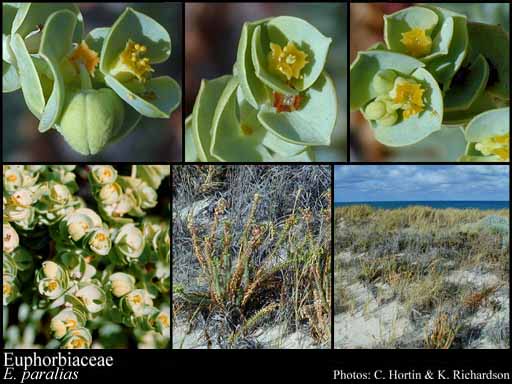- Reference
- Gen.Pl. [Jussieu] 384 (1789)
- Name Status
- Current

Scientific Description
Common name. Spurge Family.
Habit and leaf form. Trees, or ‘arborescent’, or shrubs, or herbs, or herbaceous climbers, or lianas; laticiferous, or non-laticiferous and without coloured juice (e.g. Phyllanthoideae), or with coloured juice (rarely). ‘Normal’ plants, or switch-plants; often with the principal photosynthesizing function transferred to stems, or phyllodineous, or ‘cactoid’ (often). Leaves well developed, or much reduced. Plants succulent, or non-succulent. Self supporting, or climbing. Mesophytic, or xerophytic. Leaves minute to large; alternate (usually), or opposite to whorled (rarely); spiral, or distichous; ‘herbaceous’, or leathery, or fleshy, or membranous, or modified into spines; petiolate to sessile; non-sheathing; gland-dotted, or not gland-dotted; simple (usually), or compound; when compound, palmate. Leaf blades entire; pinnately veined, or palmately veined. Leaves with stipules (nearly always, but the stipules sometimes reduced to branched hairlike structures, or to glands). Stipules scaly, or leafy, or spiny, or represented by glands; caducous, or persistent. Leaves without a persistent basal meristem. Domatia recorded (from 7 genera); represented by pits, or pockets, or hair tufts (rarely). Leaf anatomy. Urticating hairs present (in a few lianes), or absent. Stem anatomy. Nodes tri-lacunar, or unilacunar. Secondary thickening developing from a conventional cambial ring (mostly, even in lianes), or anomalous; from a single cambial ring.
Reproductive type, pollination. Fertile flowers hermaphrodite (rarely), or functionally male and functionally female, or functionally male, or functionally female. Unisexual flowers present, or absent (rarely). Plants monoecious, or dioecious, or hermaphrodite (very rarely: species of Drypetes, Aporosa). Entomophilous.
Inflorescence and flower features. Flowers aggregated in ‘inflorescences’. The terminal inflorescence unit nearly always cymose (commonly the first branching racemose, with all the subsequent branching cymose). Inflorescences terminal, or axillary; with involucral bracts, or without involucral bracts; pseudanthial, or not pseudanthial. Flowers bracteate, or ebracteate; minute, or small, or medium-sized; regular. Free hypanthium absent. Hypogynous disk present (commonly), or absent; of separate members, or annular. Perianth sepaline, or vestigial, or absent, or petaline (occasionally); when present, (3–)5–6(–12); 1 -whorled (usually), or 2 -whorled (sometimes — e.g. Jatropha); when two-whorled, isomerous; free, or joined. Calyx 5; polysepalous, or gamosepalous; regular. Corolla when present, 5; polypetalous; regular. Fertile stamens present, or absent (female flowers). Androecium 1–1000 (i.e. to ‘many’). Androecial members branched (e.g. Ricinus), or unbranched; free of the perianth; free of one another, or coherent (may be free or united in a variety of ways). Androecium exclusively of fertile stamens. Stamens 1–1000; reduced in number relative to the adjacent perianth to polystemonous; erect in bud, or inflexed in bud. Anthers dehiscing via longitudinal slits, or dehiscing via pores (rarely with apical pores); extrorse, or introrse; bilocular to four locular; bisporangiate, or tetrasporangiate. Fertile gynoecium present, or absent (male flowers). Gynoecium (2–)3 carpelled, or 4–30 carpelled (rarely). The pistil (2–)3 celled (usually), or 4–30 celled. Gynoecium syncarpous; synovarious, or synstylovarious; superior. Ovary plurilocular; (2–)3 locular, or 4–30 locular (rarely). Styles 3 (usually), or 6(–12) (or more); free, or partially joined (to almost completely joined, in the Phyllantheae); apical. Stigmas 3 (usually), or 6(–12) (or more); dry type; papillate, or non-papillate; Group II type. Placentation axile, or apical. Ovules 1 per locule, or 2 per locule; pendulous; epitropous; with ventral raphe (usually), or with dorsal raphe; when two, collateral; arillate (often carunculate), or non-arillate; orthotropous, or anatropous, or hemianatropous.
Fruit and seed features. Fruit non-fleshy (usually), or fleshy; dehiscent, or indehiscent, or a schizocarp. Mericarps when schizocarpic, consisting of one-seeded mericarps. Fruit a capsule, or a drupe; elastically dehiscent (schizocarpic capsules often splitting elastically), or passively dehiscent. Seeds endospermic (nearly always). Endosperm oily. Cotyledons 2 (usually wider than the radicle). Embryo chlorophyllous (4/6), or achlorophyllous (8/10 — Euphorbia being variable); straight, or curved. Seedling. Germination phanerocotylar, or cryptocotylar.
Physiology, biochemistry. Mustard-oils present (Drypetes, Putranjiva), or absent. Aluminium accumulation demonstrated (but in relatively few genera), or not found. Photosynthetic pathway: C3, C4, and CAM.
Geography, cytology, number of species. World distribution: cosmopolitan, except Arctic. X = 6–14 (or more). 5000 species.
Economic uses, etc. Commercial products include rubber (Hevea), tung oil (Aleurites), castor oil (Ricinus), and cassava and tapioca (Manihot). Many ornamentals, especially from Euphorbia (poinsettia, etc.), Codiaeum (croton), Phyllanthus (Otaheite gooseberry).